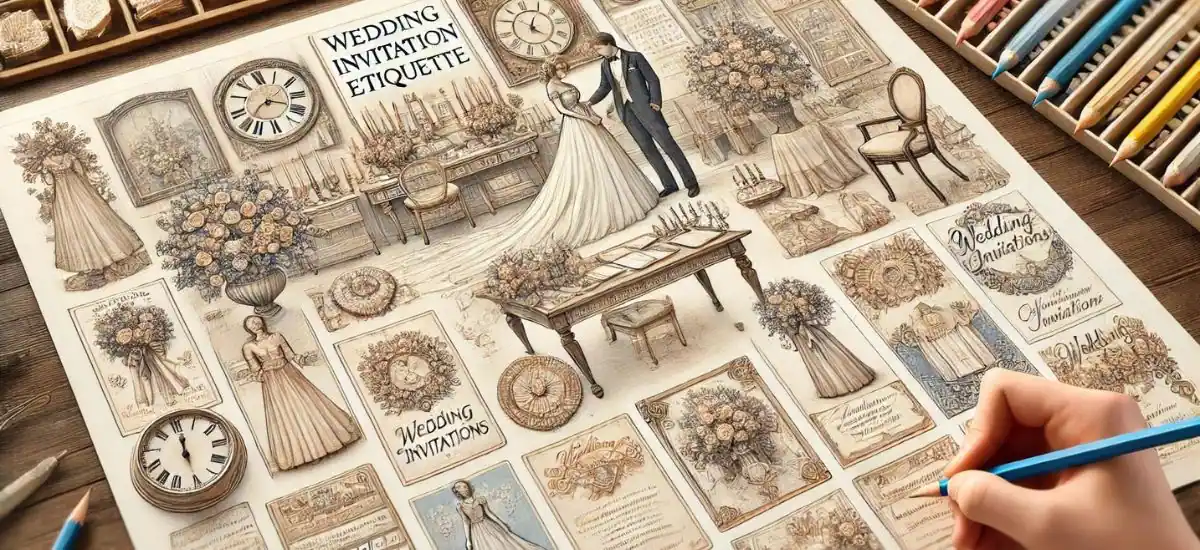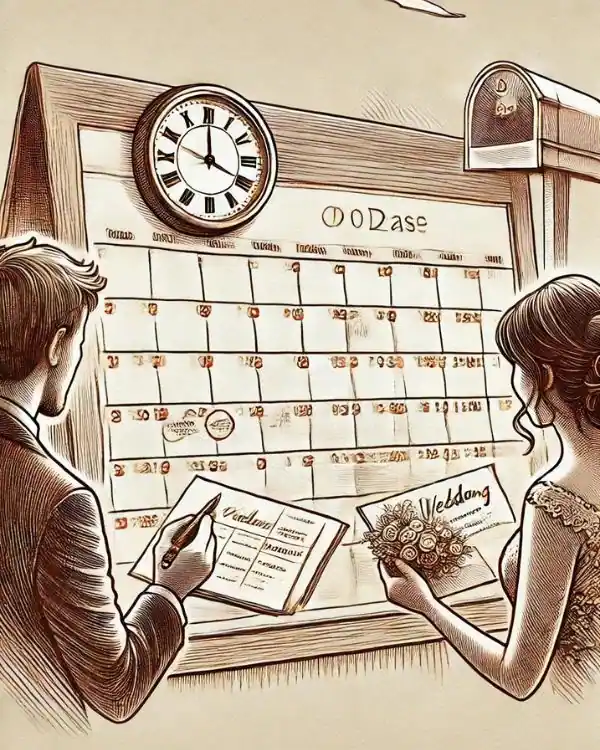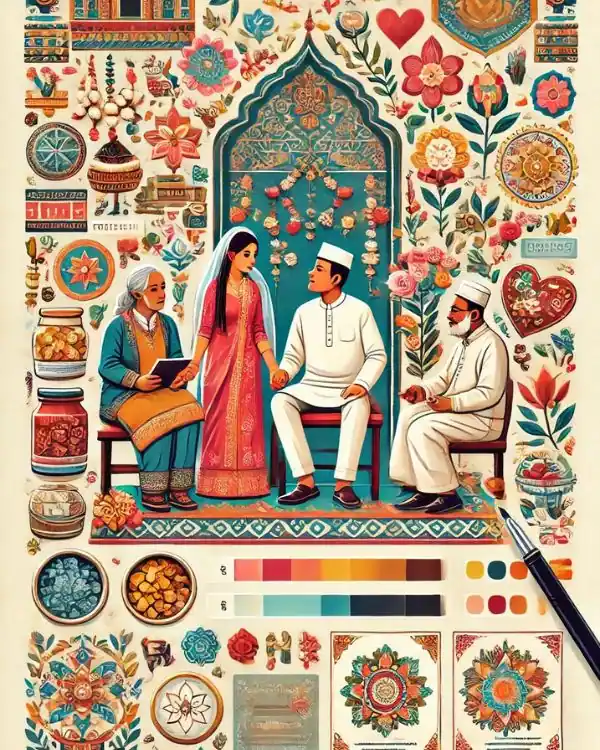Advertisement
By IS Team
Mistakes To Avoid: The Ultimate Guide To Wedding Invitation Etiquette

Advertisement
Imagine each invite as a small window into the soul of your celebration—a reflection of both your love story and the meticulously planned event that awaits.
As you embark on this journey, we'll navigate together through common pitfalls and fine-tune the nuances, ensuring your invites not only announce your big day but also set the stage for an unforgettable experience.
Join us as we transform simple cards into gateways of anticipation and excitement.
Timing and Scheduling Errors
Advertisement

Proper timing is crucial when sending out wedding invitations to ensure maximum attendance. Here’s how to get it just right:
Sending Invitations Too Early or Too Late
Aim to send wedding invitations six to eight weeks before your ceremony. This timeframe helps avoid scheduling conflicts for your guests and ensures your event remains a priority on their calendars.
Importance of Timing for Save-the-Dates and RSVP Deadlines
- Save-the-Dates should be mailed four to six months in advance, especially for destination weddings or if your wedding coincides with major holidays.
- Set your RSVP deadline for three to four weeks before your wedding day to finalize the headcount and arrangements comfortably.
How to Calculate the Perfect Time to Send Out Your Invitations
Consider the location and time of year. Local weddings require less notice, while destination events might need invitations sent out three months in advance. Always account for any seasonal holidays or expected delays in mail services.
By following these guidelines, you’ll ensure that your wedding invitations are sent at the optimal time, making it easy for guests to attend and celebrate with you. 🕒
Errors in Invitation Design
Designing an appealing and functional wedding invitation is crucial for setting the right tone for your event. Here’s how to avoid common design pitfalls:
Cluttered and Hard-to-Read Invitation Designs
Keep your invitation design simple and elegant. Avoid clutter by limiting text and using clear, legible fonts. This ensures that all essential details are easy to find and read.
Choosing Inappropriate Themes or Colors
Ensure the theme and colors of your invitation align with the style and formality of your wedding. Opt for harmonious color schemes and appropriate themes that match the vibe of your event, enhancing the overall aesthetic.
Importance of Legibility and Aesthetics in Design Choices
Focus on legibility by choosing fonts that are both stylish and readable. Maintain a strong contrast between text and background colors to ensure information stands out. Balancing beauty with functionality makes your invitations both informative and inviting.
By adhering to these design principles, your wedding invitations will effectively communicate your event details while impressing your guests with their aesthetic coherence and clarity.
Wording and Etiquette Mishaps
Advertisement

The wording of your wedding invitations is just as crucial as their design, serving as a formal announcement of your big day. Here's how to navigate common wording and etiquette mistakes to ensure your invitations are flawless and respectful.
Incorrect Use of Titles and Names
Always double-check the spelling and formal titles of all names on your invitation. This includes honorifics such as Mr., Mrs., Dr., etc., particularly for family members and close friends. Addressing your guests correctly shows respect and attention to detail.
Misleading or Incorrect Information About the Event
Your invitation should clearly convey all essential details of your wedding, including the date, time, location, and nature of the event. Verify all information before printing to avoid confusion or the need for corrections later. Misleading or inaccurate details can lead to logistical headaches and unhappy guests.
How to Properly Word Invitations for Various Types of Weddings
- Formal Weddings: Use a traditional and elegant tone with full names and titles. The invitation should be written in the third person, e.g., "The honor of your presence is requested..."
- Informal Weddings: A more casual tone with first names and simpler language works well, e.g., "Join us for the celebration of..."
- Religious Weddings: Include any religious phrases or customs that are important, respecting the traditions and expectations of the faith.
- Secular Weddings: Focus on the celebratory aspect without religious overtones, using welcoming and inclusive language.
Crafting your invitations with clear, accurate, and respectful wording ensures that they honor the style of your wedding while providing guests with all the necessary information. This careful attention to detail helps set the stage for a joyful and well-organized celebration.
Technical Details to Watch For
Attention to detail is key in ensuring your wedding invitations are perfect. Here are some straightforward points to help you avoid common technical errors:
Typos and Grammatical Errors
- Proofread Carefully: Check all text for spelling mistakes and grammatical errors.
- Get a Second Opinion: Have someone else review the invitation to catch any errors you might have overlooked.
Incorrect Date, Time, or Location Details
- Double-check everything: Confirm the date, time, and location with your venue and vendors before printing your invitations.
- Accuracy is Key: Incorrect details can cause significant confusion and inconvenience for your guests.
Ensuring All Information is Accurate and Easy to Understand
- Keep It Simple: Use clear, concise language that’s easy for everyone to understand.
- Organize for Clarity: Use headings, bullet points, or different font sizes to highlight important details like the ceremony and reception times and locations.
- Include Helpful Extras: Consider adding a map or a link to online directions to assist guests in finding the venue easily.
These steps will help ensure your invitations are beautifully crafted and free of errors, making a great first impression on your guests.
Cultural and Religious Considerations
Advertisement

Weddings are deeply personal events that often reflect the cultural and religious backgrounds of the couple. Here’s how to ensure your invitations respectfully incorporate these important elements:
Being Mindful of Cultural and Religious Traditions
- Research and Respect: Understand the cultural and religious traditions of both families. This might involve specific symbols, colors, or phrases that are significant.
- Consult with Family Members: Involve family members or cultural advisors in the planning process to ensure accuracy and respect in representation.
Customizing Invitations to Reflect Cultural Sensitivity
- Incorporate Traditional Elements: Use design elements that reflect the couple's heritage, such as traditional motifs, scripts, or languages.
- Bilingual Invitations: If your guests speak different languages, consider bilingual invitations to ensure everyone feels included and respected.
Examples of Adapting Etiquette for Different Cultural Weddings
- South Asian Weddings: Include auspicious colors like red and gold, and perhaps add a verse or blessing in Sanskrit or the relevant language.
- Muslim Weddings: You might mention "Bismillah" (In the name of God) at the beginning of the invitation to honor Islamic traditions.
- Christian Weddings: Include phrases like "Request the honor of your presence" which is commonly used in Christian invitations for a formal tone.
- Secular or Interfaith Weddings: Highlight elements from both cultures without religious symbols, focusing on neutral yet meaningful phrasing that honors both backgrounds.
By thoughtfully integrating these cultural and religious elements, your invitations will not only inform but also celebrate the rich traditions that shape your union, making your wedding more inclusive and meaningful for all your guests.
Follow-Up and Managing RSVPs
Efficiently managing RSVPs is crucial for smooth wedding planning.Here’s a streamlined approach to handling the process:
How to Politely Remind Guests to RSVP
- Set a Clear Deadline: Clearly state the RSVP deadline on your invitations.
- Send a Friendly Reminder: If responses lag, send a gentle reminder via email or text as the deadline nears: “Looking forward to celebrating with you! Please let us know by [date] if you can join us.”
Managing the RSVP List and Following up on Missing Responses
- Stay Organized: Use a spreadsheet or an app to track responses.
- Make Personal Calls: For non-responders post-reminder, a personal phone call can help secure a definitive answer.
What to Do When Guests Do Not Follow RSVP Etiquette
- Be Understanding but Firm: If some guests still haven’t replied, send a final polite request: “We need to finalize details and would love to include you. Please confirm your attendance by [final date].”
- Plan for Last-Minute Changes: Always be ready to adjust details like seating or catering as some might confirm late.
This approach helps ensure all guests are accounted for, allowing your wedding preparations to proceed without unnecessary stress.
Advertisement
Frequently Asked Questions
1. How do I address a wedding invitation to a married couple with different last names?
List each name separately and alphabetically: "Ms. Jane Doe and Mr. John Smith."
2. Is it acceptable to include registry information directly on the wedding invitation?
It's best to avoid including registry information on the invitation. Instead, provide it on your wedding website or a separate enclosure card.
3. When should 'no kids' be mentioned on the invitation, and how do I phrase it politely?
Opt for a subtle approach by adding a line such as, "We respectfully request an adults-only celebration."
4. What should I do if someone RSVPs for more guests than were invited? Politely reach out to the guest to explain that due to space or budget constraints, you cannot accommodate extra guests but look forward to their attendance.
Advertisement
I'm Looking For!








